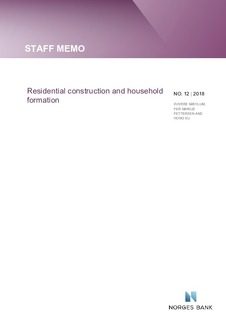| dc.contributor.author | Mæhlum, Sverre | |
| dc.contributor.author | Pettersen, Per Marius | |
| dc.contributor.author | Xu, Hong | |
| dc.date.accessioned | 2019-01-22T13:11:44Z | |
| dc.date.available | 2019-01-22T13:11:44Z | |
| dc.date.issued | 2018 | |
| dc.identifier.isbn | 978-82-8379-062-7 | |
| dc.identifier.issn | 1504-2596 | |
| dc.identifier.uri | http://hdl.handle.net/11250/2581796 | |
| dc.description.abstract | Population growth in Norway over the past 10-15 years has been strong, while residential construction activity has been fairly low. At the same time, household size continues to decline. The increase in the number of households has been higher than the increase in the number of new housing units built, particularly in urban areas. This construction shortfall has contributed to rapid house price inflation in this period. Since end-2015, population growth has slowed and the number of new units built has increased, which has reduced the construction shortfall. | nb_NO |
| dc.language.iso | eng | nb_NO |
| dc.publisher | Norges Bank | nb_NO |
| dc.relation.ispartofseries | Staff Memo;12/2018 | |
| dc.rights | Attribution-NonCommercial-NoDerivatives 4.0 Internasjonal | * |
| dc.rights.uri | http://creativecommons.org/licenses/by-nc-nd/4.0/deed.no | * |
| dc.subject | residential construction | nb_NO |
| dc.subject | households | nb_NO |
| dc.subject | urbanisation | nb_NO |
| dc.title | Residential Construction and Household Formation | nb_NO |
| dc.type | Working paper | nb_NO |
| dc.description.version | updatedVersion | nb_NO |
| dc.subject.nsi | VDP::Samfunnsvitenskap: 200::Økonomi: 210::Samfunnsøkonomi: 212 | nb_NO |
| dc.source.pagenumber | 20 | nb_NO |

